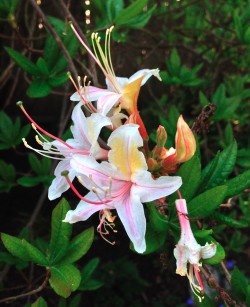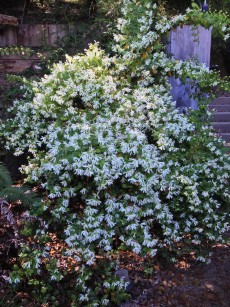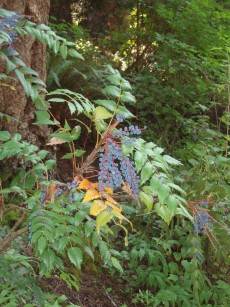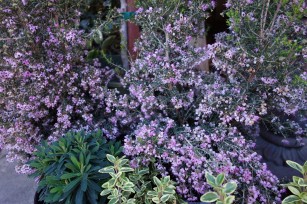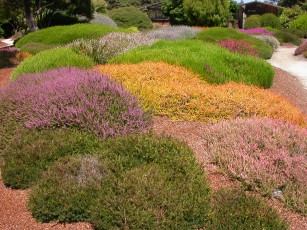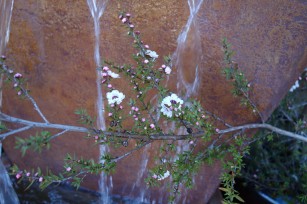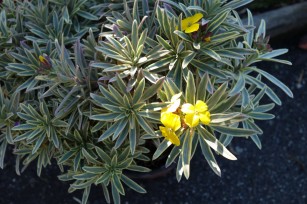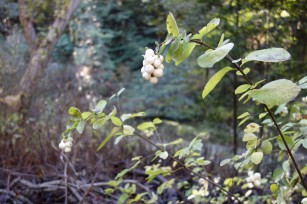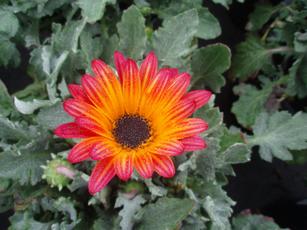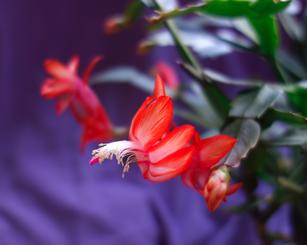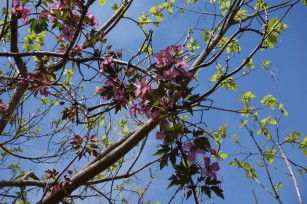 The self -described "Hillbilly Gardener" lives In the banana belt above Scotts Valley Civic Center. Technically, Richard Hencke says he is 1/4 German, 1/4 irish, and 1/2 hillbilly from his childhood in Texas and Oklahoma. A true gardener at heart, Richard spends much of his time as an emergency room doctor at a local hospital and the rest of his time tending his garden. With trees and plants collected in his early days as a Boy Scout in Port Arthur, Texas, as well as plants acquired from the far corners of the earth he has created a spectacular landscape surrounding his home. "They'll carry me out of this property in a pine box", Richard says. He clearly loves his personal arboretum.
The self -described "Hillbilly Gardener" lives In the banana belt above Scotts Valley Civic Center. Technically, Richard Hencke says he is 1/4 German, 1/4 irish, and 1/2 hillbilly from his childhood in Texas and Oklahoma. A true gardener at heart, Richard spends much of his time as an emergency room doctor at a local hospital and the rest of his time tending his garden. With trees and plants collected in his early days as a Boy Scout in Port Arthur, Texas, as well as plants acquired from the far corners of the earth he has created a spectacular landscape surrounding his home. "They'll carry me out of this property in a pine box", Richard says. He clearly loves his personal arboretum.
On a clear spring day recently, Richard gave me the royal tour. I visited this garden 2 years ago and I couldn't help but be impressed with incredible growth he has coaxed from his many blooming trees, conifers and vines.
The Pride of Madeira spikes glowed in the sun, some cobalt blue, others vivid purple. Early spring blooming shrubs and perennials offered color at every turn.
One of his passions is allowing flowering vines that grow up into the canopy of his trees which adds one more dimension to his landscaping. A Blood Red trumpet vine is happily inching up a redwood trunk while a butter yellow rosa banksia scrambles into an oak. On a fence along a walk a spectacular blooming double white pandorea vine has found a home in a Butternut tree he got in Pennsylvania. A rose colored anemone clematis nearly covered the trunk and branches of a dormant catalpa.
Fragrance and color as well as good "bones" or structure make Richard's garden breathtaking. He nurtures each seedling with the same care he gives to the large trees. I laughed as he pointed out a 15 ft tall aralia elata that was transplanted from a tiny dish garden received many years ago as a gift. One of his favorite trees is a white pine gleaned from his grandmother's place in the Blue Ridge Mountains in Virginia. A black cottonwood he picked up in New England, 2 maples hail from New Orleans and the sisal agave grew from tiny pups he found at a rest stop on Hwy 280 in case he ever wants to make rope or twine.
Richard likes to naturalize Hawaiian native plants starting them mostly from seed collected while on vacation. He has several Sacred Koa or A'ali'i growing on the property. Since this dodonaea species grows at 5000 ft elevation up Moana Loa they have adapted nicely to his Scotts Valley climate. I wouldn't be surprised if Richard goes into the canoe or lei making business when his trees grow up.
A small portion of Richard's garden is fenced but most is open to the deer. So far the branches growing 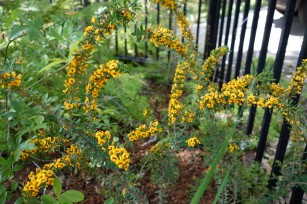 through the fence of his bright golden pea-like Eutaxia obovata have not attracted them. Also known as Egg and Bacon shrub this plant is a compact shrub originating from Western Australia. It's graceful fountain shape really shows off the thousands of flowers adorning the branches.
through the fence of his bright golden pea-like Eutaxia obovata have not attracted them. Also known as Egg and Bacon shrub this plant is a compact shrub originating from Western Australia. It's graceful fountain shape really shows off the thousands of flowers adorning the branches.
Like all devoted gardeners, Richard likes to share plants with others. A couple of years ago he sent me home with one of his F-2 hybrid Douglas iris and this year a dendrobium orchid. I'm hoping more of his cuttings of the Sacred Flower of the Andes ( Cantua ) take and maybe I'll be lucky to get one of these, too. A day in Richard's garden is always a magical experience.


